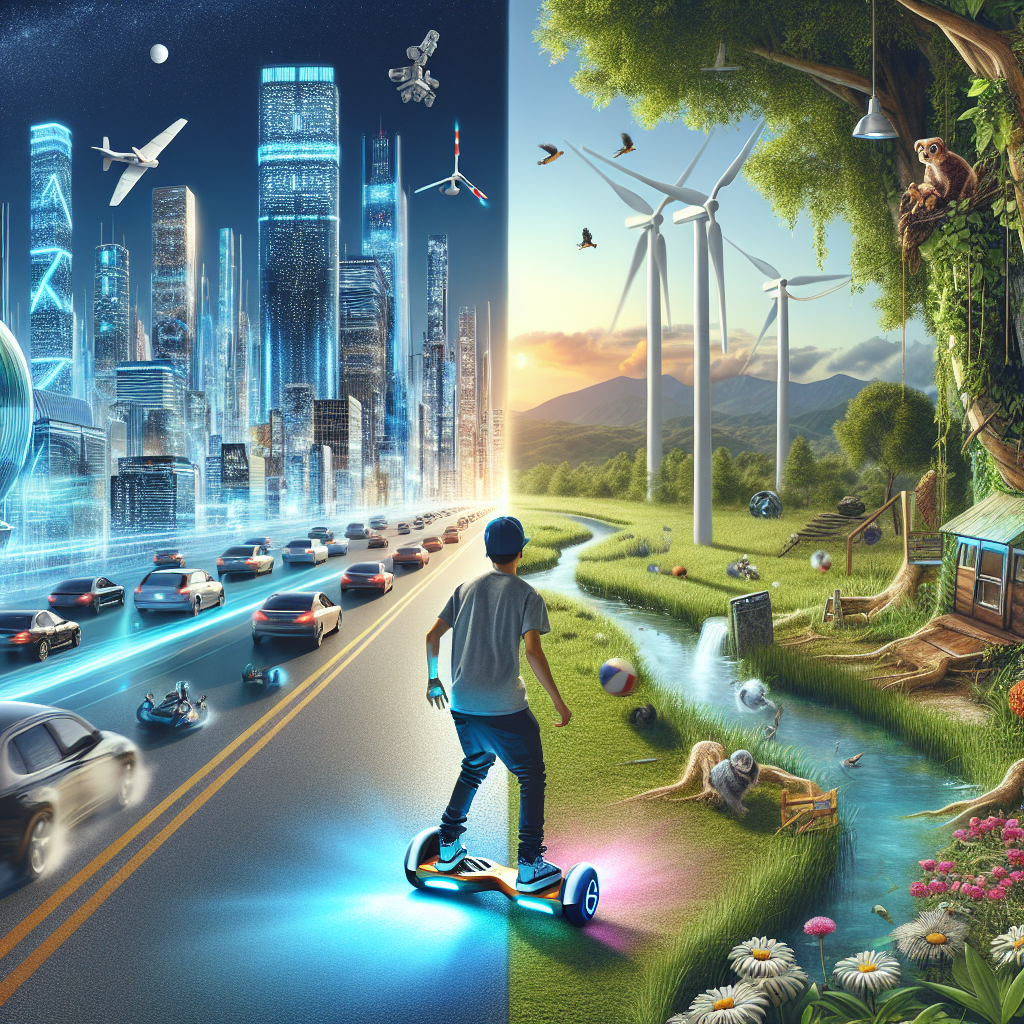Imagine cruising down the street on a sleek hoverboard, effortlessly gliding along without a care in the world. But have you ever stopped to think about the impact these high-tech gadgets have on the environment? In this article, we will explore the environmental implications of hoverboards in comparison to their traditional counterpart, the skateboard. Are hoverboards a sustainable choice or do they leave a larger carbon footprint? Let’s find out.

Manufacturing Process
Materials Used
Hoverboards require a variety of materials for their manufacturing process. These materials typically include metal (such as aluminum), plastic, rubber, and electronic components. On the other hand, traditional skateboards are primarily made of wood, specifically layers of maple or bamboo veneer for the deck, with trucks made of aluminum or steel. While both hoverboards and traditional skateboards use different materials, it is important to consider the amount and source of these materials to assess their environmental impact.
Energy Consumption
The manufacturing process of hoverboards involves several stages, including molding, assembly, and testing. These stages require energy for powering machinery, heating, and cooling processes. Likewise, traditional skateboards also require energy for cutting, shaping, and assembling the wooden deck. However, the energy consumption during the manufacturing process of hoverboards may be higher due to the involvement of additional electronic components and complex assembly processes compared to traditional skateboards.
Emissions Released
Hoverboard manufacturing can contribute to emissions of greenhouse gases and other pollutants. The use of energy-intensive processes and machinery during manufacturing can result in the release of carbon dioxide and other harmful emissions into the atmosphere. Additionally, the extraction and processing of raw materials for both hoverboards and traditional skateboards can also generate emissions. It is worth noting that traditional skateboards tend to have a lower environmental impact in terms of emissions released during manufacturing, as they involve simpler processes and fewer electronic components.
Resource Depletion
Raw Materials
Hoverboards require the extraction and processing of various raw materials. The metals used, such as aluminum, may need to be mined, which can have significant environmental impacts, including habitat destruction and groundwater pollution. The production of plastics and rubbers also relies on the extraction and processing of petroleum, a non-renewable resource. In contrast, traditional skateboards primarily utilize wood, a renewable resource when responsibly sourced from sustainably managed forests. The use of wood in traditional skateboards helps reduce the dependency on non-renewable resources and minimizes the environmental impact associated with their extraction.
Batteries
One of the key components of hoverboards is their lithium-ion batteries, which provide the necessary power for propulsion. The production and eventual disposal of these batteries present environmental challenges. The extraction and processing of lithium, cobalt, and other battery components require extensive energy and can lead to ecological damage if not managed properly. Furthermore, the disposal of lithium-ion batteries can pose a risk to the environment if not recycled or disposed of in accordance with regulations. Traditional skateboards, on the other hand, do not rely on batteries and therefore do not contribute to the environmental issues associated with battery production and disposal.

Waste Generation
Packaging Waste
Both hoverboards and traditional skateboards contribute to packaging waste during the manufacturing and distribution processes. The packaging materials used, such as cardboard boxes, plastic wrap, and foam inserts, can have negative environmental impacts if not properly managed. However, it is worth noting that traditional skateboards typically have simpler packaging requirements compared to hoverboards, as they do not require large boxes or extra padding for fragile electronic components. Overall, the packaging waste generated by hoverboards may be higher due to their complex design and additional components.
Obsolete/Non-functional Units
As with any electronic device, hoverboards may become obsolete or non-functional over time, contributing to electronic waste. These non-functional units, along with those returned due to manufacturing defects or other issues, can add to the electronic waste problem. On the other hand, traditional skateboards, being primarily made of wood, can be easily repaired or repurposed, reducing the amount of waste generated. The electronic components and batteries in hoverboards require specialized recycling processes to prevent environmental harm, whereas traditional skateboards can be more easily disposed of or recycled through conventional waste management systems.
Transportation
Shipping and Distribution
Both hoverboards and traditional skateboards undergo shipping and distribution processes to reach their end consumers. These processes involve transportation, which contributes to carbon emissions and air pollution. The environmental impact of shipping and distribution can vary depending on factors such as distance traveled, transportation modes used, and packaging efficiency. However, it is worth noting that hoverboards, being bulkier and heavier due to their electronic components, may require more fuel and generate more emissions during transportation compared to traditional skateboards, which are generally lighter and more compact.

Energy Usage
Charging
Hoverboards rely on battery power, requiring regular charging for operation. Charging these lithium-ion batteries typically requires electricity from the grid. The energy source used for electricity generation can have varying environmental impacts, depending on factors like the mix of renewable and non-renewable sources in the energy grid. It is crucial to consider utilizing renewable energy sources for charging hoverboard batteries to minimize their carbon footprint. In contrast, traditional skateboards do not require charging, operating solely through human energy, making them a more energy-efficient transportation option.
Battery Life
The battery life of hoverboards determines their overall energy usage and environmental impact. Longer-lasting batteries reduce the frequency of charging, thus minimizing the consumption of electricity and the associated emissions. The lifespan of lithium-ion batteries used in hoverboards can vary depending on factors like battery quality, usage patterns, and maintenance. It is important for manufacturers to prioritize the development and production of high-quality, long-lasting batteries to enhance the environmental sustainability of hoverboards. Traditional skateboards, which do not rely on batteries, do not face the same challenges related to battery life and energy consumption.
Emissions
Carbon Footprint
A significant concern when considering the environmental impact of hoverboards and traditional skateboards is their carbon footprint. The carbon footprint represents the total amount of greenhouse gas emissions, mainly carbon dioxide, released throughout the lifecycle of a product or activity. Hoverboards, with their reliance on battery power and energy-intensive manufacturing processes, generally have a higher carbon footprint compared to traditional skateboards. However, the carbon footprint can be mitigated by using renewable energy sources during manufacturing, charging, and transportation processes.
Air Pollution
The emissions generated from the manufacturing process, energy consumption, and transportation of hoverboards and traditional skateboards can contribute to air pollution. This air pollution can have detrimental effects on both human health and the environment. The use of non-renewable energy sources during manufacturing and charging processes can result in the release of pollutants such as sulfur dioxide, nitrogen oxides, and particulate matter. It is crucial for manufacturers and users to adopt cleaner energy sources and practices to minimize air pollution associated with the production and use of hoverboards and traditional skateboards.

Usage Patterns
Frequency of Use
The frequency of use plays a crucial role in determining the environmental impact of hoverboards and traditional skateboards. If hoverboards are used more frequently, their overall energy consumption and emissions will be higher compared to traditional skateboards. However, the frequency of use can vary depending on individual preferences and needs. Promoting responsible and efficient use of hoverboards, such as using them for shorter distances or when necessary, can help minimize the environmental impact associated with their frequent use.
Distance Covered
The distance covered by hoverboards and traditional skateboards also affects their environmental impact. If hoverboards are used for longer distances regularly, their energy consumption and emissions will be higher compared to shorter distances. Traditional skateboards, being solely dependent on human energy, have a minimal environmental impact in terms of distance covered. However, it is important to note that this may vary depending on other factors, such as the mode of transportation used for longer distances when traditional skateboards are not feasible.
Terrain Impact
Both hoverboards and traditional skateboards can have an impact on the environment depending on the terrain they are used on. Hoverboards, with their electric motors, may cause increased damage to natural terrain, such as parks or trails, compared to traditional skateboards. The weight and design of hoverboards can potentially cause more soil erosion and damage to vegetation. Traditional skateboards, if used responsibly, have a lesser impact on natural terrain due to their lighter weight and more versatile maneuverability.
Environmental Regulations
Compliance with Regulations
Manufacturers of hoverboards and traditional skateboards need to comply with environmental regulations to minimize their impact on the environment. These regulations may include guidelines regarding the manufacturing processes, waste management, emissions, and recycling initiatives. It is crucial for manufacturers to adopt sustainable practices and ensure compliance with relevant regulations to minimize the environmental impact of their products. Additionally, governments play a vital role in enforcing and updating these regulations to promote sustainable manufacturing practices in the hoverboard and skateboard industry.
Recycling Initiatives
To mitigate the environmental impact of hoverboards and traditional skateboards, recycling initiatives are essential. The recycling of electronic components, lithium-ion batteries, and other materials can help reduce the amount of waste generated and minimize the extraction of raw materials. Manufacturers should prioritize the development of efficient recycling processes and work in collaboration with recycling centers to ensure the proper disposal and recycling of end-of-life hoverboards. Traditional skateboards, being primarily made of wood, can also be recycled or repurposed through conventional waste management systems, reducing the amount of waste sent to landfills.

End of Life
Disposal Methods
The end-of-life disposal methods of hoverboards and traditional skateboards are critical in determining their overall environmental impact. Hoverboards, with their electronic components and lithium-ion batteries, require specialized disposal methods to prevent environmental harm. These methods may include recycling centers or specialized e-waste management facilities that can safely extract and recycle valuable materials while minimizing the release of hazardous substances. Traditional skateboards, being primarily made of wood, can be disposed of through conventional waste management systems or repurposed for other purposes, reducing the environmental impact of their end-of-life disposal.
E-waste Management
The disposal of hoverboards as electronic waste, also known as e-waste, requires proper management to prevent environmental pollution. E-waste can contain hazardous substances and heavy metals that can leach into the soil and water if not treated appropriately. Regulations and initiatives for the proper handling, recycling, and disposal of e-waste should be implemented and enforced to ensure the environmental sustainability of hoverboards. Traditional skateboards, being primarily made of wood, do not contribute to e-waste and can be more easily managed through existing waste management systems.
Benefit Analysis
Sustainability
When comparing the environmental impact of hoverboards and traditional skateboards, sustainability is a key factor to consider. Traditional skateboards, with their reliance on renewable materials like wood, have a more sustainable manufacturing process and a lower carbon footprint. Their simple design and lack of batteries allow for easy repairs and repurposing, extending their lifespan and reducing waste. Hoverboards, on the other hand, have a higher carbon footprint due to their energy-intensive manufacturing processes and battery reliance. However, hoverboards can still be made more sustainable through the use of renewable energy sources, efficient manufacturing techniques, and responsible end-of-life disposal practices.
Efficiency
Efficiency is another important aspect to assess when examining the impact of hoverboards and traditional skateboards on the environment. Traditional skateboards, being solely dependent on human energy, are highly efficient in terms of energy consumption and emissions. The lack of battery charging requirements further contributes to their efficiency. Hoverboards, while providing a different mode of transportation, require energy for charging and have higher energy consumption overall. However, advancements in battery technology, longer battery life, and increased use of renewable energy sources can enhance the efficiency of hoverboards and reduce their environmental impact.
In conclusion, hoverboards and traditional skateboards have different environmental impacts throughout their lifecycle. Hoverboards, with their complex manufacturing processes, battery reliance, and electronic waste management challenges, generally have a higher environmental impact compared to traditional skateboards. However, the environmental impact can be reduced through the use of sustainable materials, energy-efficient manufacturing techniques, renewable energy sources, responsible usage patterns, and proper end-of-life disposal methods. It is important for manufacturers, consumers, and policymakers to prioritize sustainability and efficiency in the hoverboard and skateboard industry to minimize their impact on the environment.

